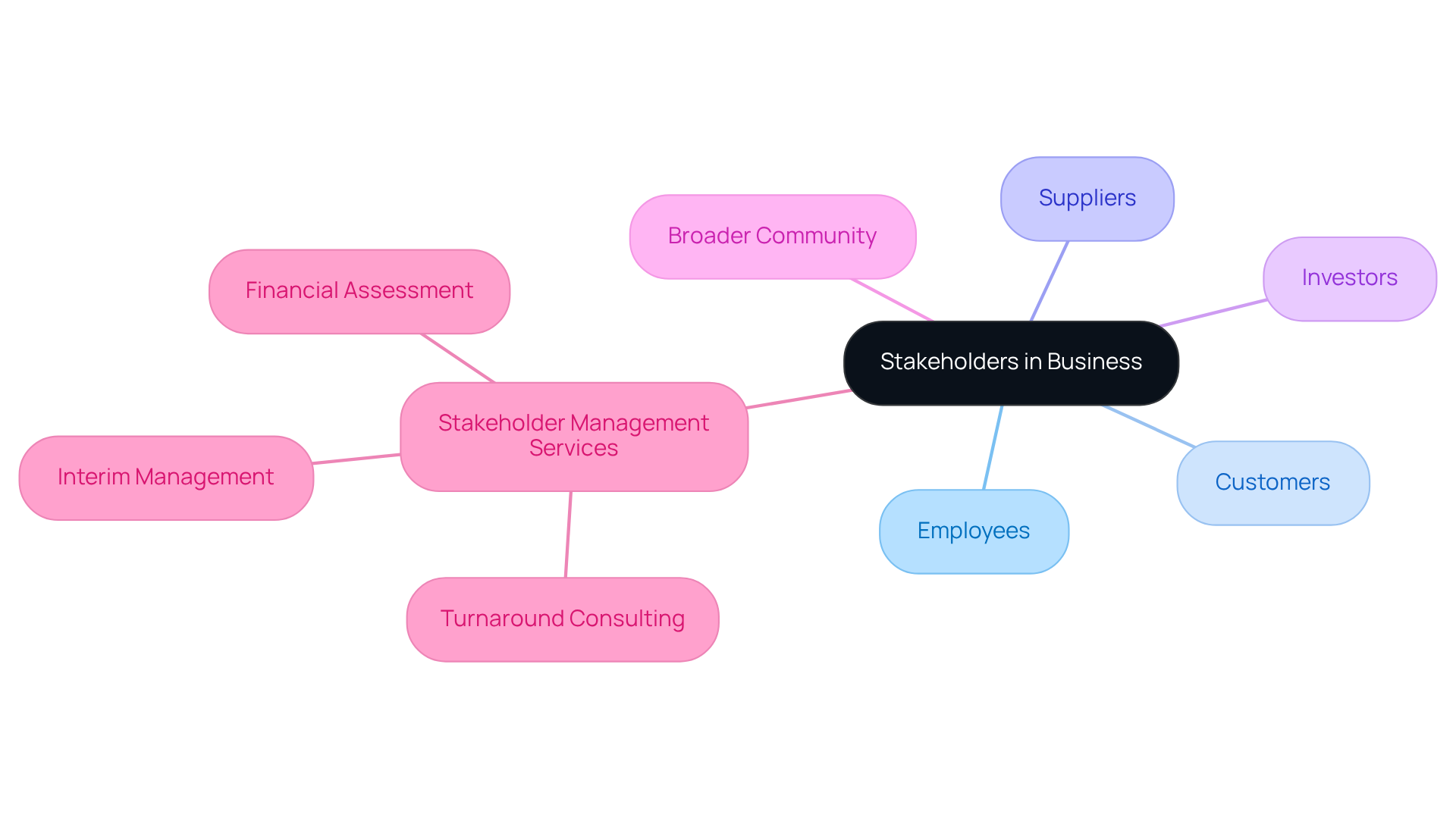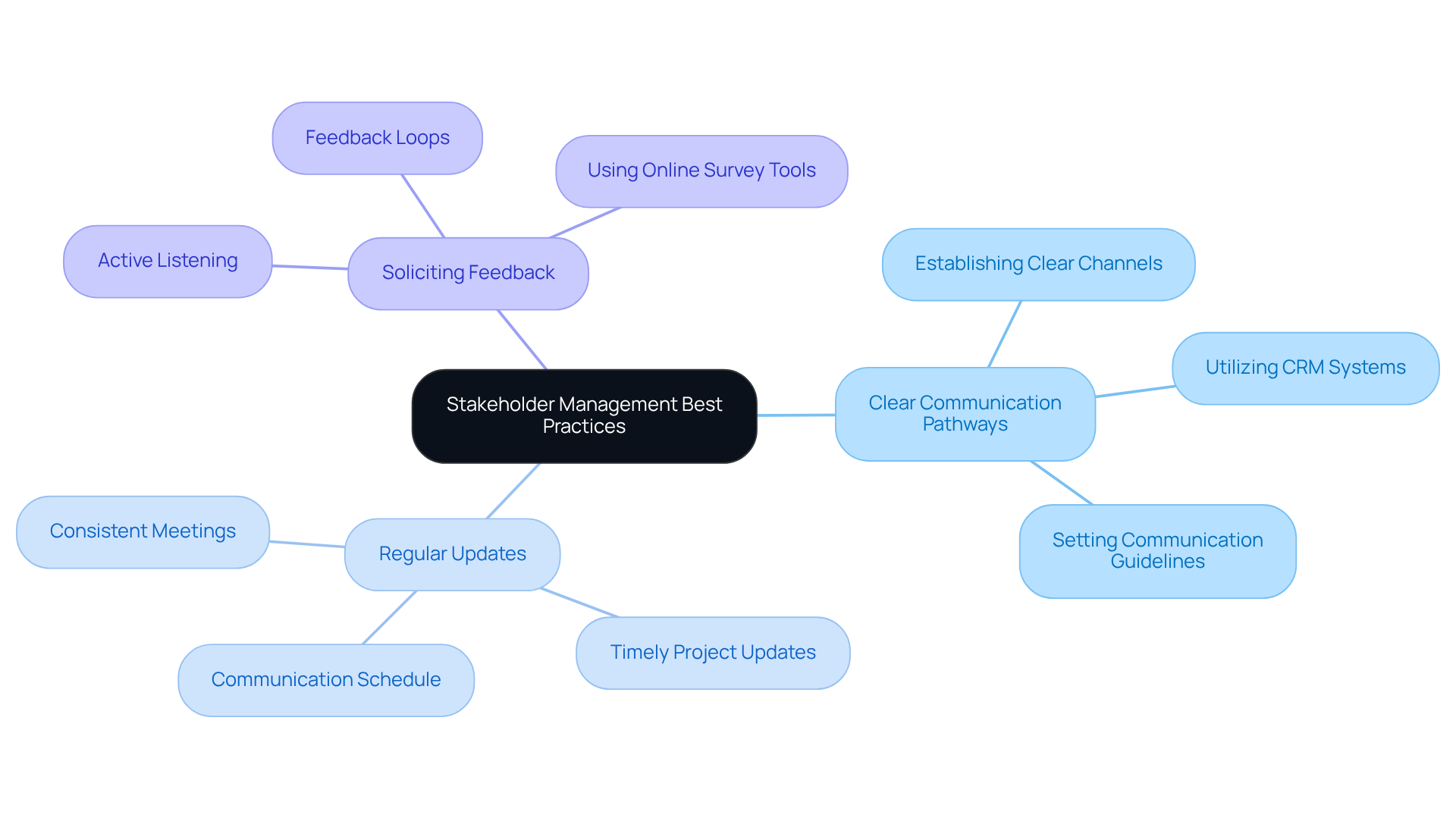Overview
This article delineates four essential steps for effective stakeholder identification and management.
- It emphasizes the critical need to recognize stakeholders.
- Next, it advocates for analyzing their interests and influence.
- Furthermore, prioritizing engagement is vital, along with the implementation of best communication practices.
- Evidence supports this approach, demonstrating that effective stakeholder management significantly enhances project outcomes.
Maintaining strong relationships and clear communication with key parties can substantially improve a company's capacity to navigate challenges and achieve its objectives. Therefore, it is imperative to adopt these strategies to foster successful stakeholder relationships.
Introduction
Understanding the intricate web of relationships that underpin any successful business venture is essential. Stakeholders—ranging from employees to investors—play a pivotal role in determining outcomes. Effective stakeholder identification and management not only enhance engagement but also empower organizations to navigate challenges with agility. Yet, how can businesses ensure they are effectively recognizing and prioritizing these crucial players? This article delves into four essential steps that can transform stakeholder management from a mere checklist into a strategic advantage. Ultimately, fostering stronger relationships and driving project success is not just desirable; it is imperative.
Define Stakeholders and Their Importance in Business
Stakeholders are individuals or groups whose interests are addressed through stakeholder identification and management in the success or failure of a business or project. This group includes:
- Employees
- Customers
- Suppliers
- Investors
- The broader community
Understanding the significance of stakeholder identification and management is crucial, as their support can profoundly impact a company's ability to achieve its objectives. For example, in a restructuring scenario, engaging employees fosters a sense of ownership and mitigates resistance to change. Additionally, keeping investors informed sustains their confidence and support during challenging periods.
Moreover, leveraging services such as:
- Turnaround and restructuring consulting
- Interim management
- Financial assessment
can improve stakeholder identification and management. These services provide the essential framework for companies to address concerns effectively, ensuring that all viewpoints are acknowledged and integrated into decision-making processes. By prioritizing stakeholder identification and management, businesses can navigate complexities with greater resilience and adaptability.

Identify Key Stakeholders and Their Interests
Effective stakeholder identification and management starts with recognizing all potential contributors. This process of stakeholder identification and management involves creating a comprehensive list and categorizing these contributors based on their influence and engagement within the project or enterprise.
Utilizing strategies such as mapping key players allows organizations to visualize these connections and concerns clearly. For instance, a retail company undergoing restructuring may identify crucial parties, including:
- Suppliers
- Employees
- Customers
Each group possesses distinct priorities:
- Suppliers focus on timely payments
- Employees seek job security
- Customers demand high-quality service
By understanding these interests, organizations can enhance their stakeholder identification and management, tailoring their communication and engagement strategies to ensure that the most critical participants are prioritized in discussions and decision-making processes.
This targeted approach not only cultivates stronger relationships but also increases the likelihood of successful project outcomes. In fact, 93% of corporate leaders agree that establishing and maintaining trust enhances profitability, underscoring the strategic importance of effective relationship management.

Analyze and Prioritize Stakeholders for Effective Engagement
Recognizing the involved parties is just the beginning; the next crucial step in stakeholder identification and management is to assess their impact and engagement levels. Utilizing tools such as the Power-Interest Grid enhances stakeholder identification and management by allowing organizations to categorize participants into four distinct quadrants:
- High power/high engagement
- High power/low engagement
- Low power/high engagement
- Low power/low engagement
This structured analysis is vital for effectively prioritizing strategies related to stakeholder identification and management. For instance, those in the high power/high significance quadrant necessitate close supervision and regular updates, as their support is essential for success. Conversely, parties in the low power/low interest quadrant may require less frequent communication, thereby enabling more efficient allocation of resources.
Studies indicate that firms excelling in public engagement are 40% more likely to complete tasks on time and within budget. Furthermore, 78% of initiatives flourish with engaged participants, compared to just 40% when involvement is minimal. By concentrating efforts on the most impactful participants, businesses can refine their engagement strategies, ultimately leading to improved project outcomes and overall success.
As Phil Rabinowitz aptly noted, 'Stakeholder identification and management—managing interested parties by keeping them engaged and supportive—can be facilitated by analyzing their needs.' Additionally, the Project Management Institute (PMI) emphasizes that stakeholder identification and management is essential to secure involvement and backing from interested parties, as it is important to comprehend not only who potential contributors are but also the nature of their interest in the endeavor.
This comprehensive approach underscores the importance of participant analysis while also highlighting potential pitfalls in engagement, as illustrated in Case Study A, where ambiguous project requirements led to difficulties in participant involvement. By learning from such cases, companies can navigate the complexities of managing diverse interests more effectively.

Implement Best Practices for Stakeholder Management and Communication
A structured approach to communication and engagement is essential for effective stakeholder identification and management, especially during transformative periods. Best practices include:
- Establishing clear communication pathways
- Scheduling regular updates
- Actively soliciting feedback from those involved
For example, a restaurant undergoing a turnaround can significantly benefit from consistent meetings with staff to discuss changes and gather input, ensuring that employees feel valued and heard. Additionally, leveraging technology, such as Customer Relationship Management (CRM) systems, can streamline communication and track interactions, thereby enhancing overall efficiency.
By fostering open lines of communication and involving interested parties through stakeholder identification and management in decision-making processes, businesses can cultivate trust and support—both vital for overcoming challenges and achieving sustainable success. Frequent updates not only keep interested parties informed but also boost their involvement, strengthening their commitment to the goals of the initiative. Notably, poor communication accounts for failure one-third of the time, underscoring the necessity of efficient communication with involved parties. As Katie Garrett aptly states, 'Stakeholder communication is vital for the success of an initiative.' It ensures that interested parties remain informed, engaged, and supportive throughout the process.
Moreover, prioritizing stakeholder identification and management has been shown to greatly enhance project outcomes, as evidenced by numerous case studies on the management of interested groups. The transformative experience provided by the SMB team through their 'Rapid30' plan exemplifies how effective stakeholder engagement can lead to substantial improvements in both financial and operational performance.

Conclusion
Understanding and managing stakeholders is a critical component of achieving business success. Stakeholders—ranging from employees and customers to investors and the broader community—significantly influence the trajectory of any project or initiative. By effectively identifying and engaging these groups, organizations can foster support, mitigate resistance, and enhance overall performance.
This article outlines a structured approach to stakeholder identification and management, emphasizing the importance of recognizing key players and their unique interests. Strategies such as stakeholder mapping and the Power-Interest Grid facilitate targeted engagement, ensuring that communication and resources are directed where they will have the most significant impact. Moreover, implementing best practices for communication strengthens relationships and promotes trust, which is essential during times of change.
Ultimately, effective stakeholder management is not just a best practice but a necessity for navigating complex business environments. By prioritizing stakeholder interests and maintaining open lines of communication, organizations can cultivate a supportive ecosystem that drives success. Embracing these principles will empower businesses to not only meet their objectives but also to thrive in an ever-evolving landscape.
Frequently Asked Questions
Who are considered stakeholders in a business?
Stakeholders include individuals or groups such as employees, customers, suppliers, investors, and the broader community.
Why is stakeholder identification and management important?
It is crucial because stakeholders' support can significantly impact a company's ability to achieve its objectives. Engaging stakeholders can foster ownership and reduce resistance to change.
How can engaging employees benefit a business during restructuring?
Engaging employees during restructuring fosters a sense of ownership and helps mitigate resistance to change.
What role do investors play in stakeholder management?
Keeping investors informed sustains their confidence and support, especially during challenging periods.
What services can improve stakeholder identification and management?
Services such as turnaround and restructuring consulting, interim management, and financial assessment can enhance stakeholder identification and management.
How do these services benefit companies?
These services provide a framework for addressing stakeholder concerns effectively, ensuring that all viewpoints are acknowledged and integrated into decision-making processes.
What is the overall benefit of prioritizing stakeholder management?
Prioritizing stakeholder management allows businesses to navigate complexities with greater resilience and adaptability.




